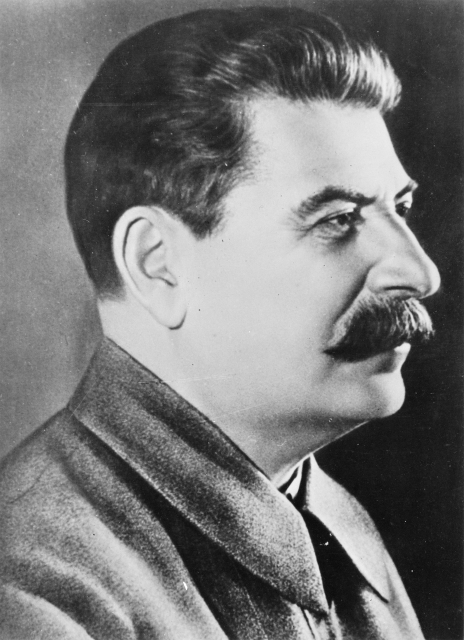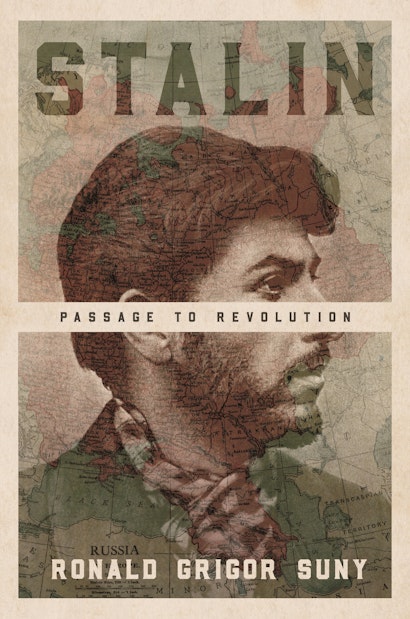“No one can be regarded as a born criminal. One cannot look at Stalin in the same light in 1918, in 1924, or in 1937. It is the same person, and yet it is not. In the ten years after he succeeded Lenin, he changed markedly. Yet that is the difficulty of creating his political portrait: while ap parently struggling for the ideals of socialism—however twistedly understood—he committed crime after crime.”
—Dmitrii Volkogonov, Stalin: Triumph and Tragedy (1991)
“Do not expect more from the truth than it actually contains.”—Russian proverb
In the spring of 1924, Stalin’s nemesis and rival, Lev Trotsky, told the “Old Bolshevik” Vladimir Smirnov, “Stalin will become the dictator of the USSR.” “Stalin?” Smirnov reacted. “But he is a mediocrity, a colorless non-entity.” “Mediocrity, yes,” Trotsky mused, “non-entity, no. The dialectics of history have already hooked him and will raise him up. He is needed by all of them—by the tired radicals, by the bureaucrats, by the Nepmen, the kulaks, the upstarts, the sneaks, by all the worms that are crawling out of the upturned soil of the manured revolution.”1
Stalin continues to fascinate—the central mystery within the riddle inside the enigma that was the Soviet Union. Ordinary in many ways, hardly a mediocrity, he rose to extraordinary heights. Toward the end of his life he was arguably the most powerful individual in the world. Yet at various earlier times he was seen as a “gray blur,” “the man who missed the revolution,” a “mediocrity” hooked by history. He was Lenin’s “marvelous Georgian,” in wartime the “Generalissimo,” and still later “history’s villain.”
Yet the telling of Stalin’s life story has always been more than biography. There is wonder at the achievement—the son of a Georgian cobbler ascending the heights of world power, the architect of an industrial revolution and the destruction of millions of the people he ruled, the leader of the state that stopped the bloody expansion of fascism. Stalin’s story is the story of the making of the Soviet Union and a particular vision of what he called socialism. His biographers have often placed historical imagination at the service of a specific politics of eroding (or lauding) the Stalinist inheritance. Such a life story cannot be separated from an evaluation of that life’s work. In twenty-first century Russia visions of Stalin are deployed to justify yet another slide into authoritarianism, while in the West the entirety of the Soviet experience is often reduced to Stalin and Stalinism, the Great Purges, and the gulag. The drama of his life, the achievements and tragedies, are so morally and emotionally charged that they challenge the usual practices of historical objectivity and scholarly neutrality. As his heirs and victims have tried to make sense of Stalin, tales or rumors have been used to illuminate the dark corners of the Soviet past. Imaginative portraits, like those by great novelists like Alexander Solzhenitsyn or Vasilii Grossman, doubtless help us to sense the interior of the dictator’s mind but contain fictions or at best half-fictions.2 When it comes to Stalin, gossip is reported as fact, legend provides meaning, and scholarship gives way to sensationalist popular literature with tangential reference to the reliable sources.
Most elusive and obscure have been Stalin’s early years—before he was Stalin. Here the lasting fascination with the demon dictator is matched by an irresistible temptation to make his childhood and youth “useful” by investing them with the first signs of the paranoid revolutionary-from-above of the 1930s, the arch criminal who presided over the death of millions. Those who “know” the autocratic Stalin of totalitarian Russia have read back the characteristics of the General Secretary into the young Stalin, emphasizing what fits—violence, paranoia, arrogance, and the need to dominate—and rejecting what does not—romanticism, literary sensibility, love for his homeland, and revolutionary idealism. As important as Stalin’s early life was to the formation of his personality, the difficulties of reconstructing it from the few extant memoirs of his youth and scanty available documentation have led sometimes to flimsily built psychoanalytic speculation and at other times to fanciful arguments that Stalin must have been an agent for the tsar’s Okhrana (political police).3
From the earliest attempts at understanding Stalin, biographers have drawn conclusions about the mature Stalin from the psychological, not to mention physical, blows suffered by the young Ioseb Jughashvili. His boyhood friend, Ioseb Iremashvili, later a political opponent, composed the first memoir of Stalin’s childhood and made the primary psychological deduction later followed by other biographers: “Undeserved, terrible beatings made the boy as hard and heartless as his father himself. Since all men who had authority over others either through power or age reminded him of his father, there soon arose a feeling of revenge against all men who stood above him. From his youth the realization of his thoughts of revenge became the goal toward which everything was aimed.” Stalin evidently evaluated his parents’ disciplining differently from Iremashvili. When popular German biographer Emil Ludwig, known for his interviews with the political celebrities of the interwar years, met with Stalin in the Kremlin, he indelicately broached the issue of parental abuse: “What pushed you into opposition? Perhaps the bad treatment by your parents?” Stalin did not take the bait, however. “No,” he answered. “My parents were uneducated people, but they treated me not badly at all.” 4
Reducing the complexity of the biographical subject to a single explanatory key, in this case parental abuse, impoverishes explanation, and most historians have been suspicious of a method that leaves so much out—culture and context, politics and ideas—and renders stated motivations suspect, reducing them to psychological functions (rationalization, compensation, sublimation). Stalin is without doubt one of the most tempting and, at the same time, least hospitable subjects for a biographer. Not particularly introspective, he left few intimate letters, no secret diary, and many dubious witnesses to his inner life. Moreover, Bolshevik political culture was hostile to open personal expression and imposed on Stalin and other adherents an enforced modesty. Denial of the importance of self was part of the Social Democratic tradition, and even as a grotesque cult of Stalin’s personality grew to gargantuan proportions Stalin would continue, disingenuously, to claim that he disliked all the fuss. At different times in his life Stalin created distinct narratives about who he was. In the 1930s that narrative drew parallels with Peter the Great and then with Ivan the Terrible. His earlier narratives were romances about Georgia, the revolutionary hero, the practical man of the underground, the hardened, steeled Bolshevik, who in time became the Lenin loyalist, the man of the moderate middle, and soon afterward the radical transformer of Russia’s reality.
Yet for all his dissembling and deception, his playacting and posturing, Stalin revealed himself through what he did and said in public and—now that archives are open and more reliable testimonies have come forth—in private as well. For the first time biographers are able to place the man in his world, show his limits as well as talents, and work toward a portrait that might explain the seemingly inexplicable. Stalin was an exceptional individual because of what he became and what he did, the positions he occupied in a tumultuous time, but like many people in higher politics he was at the same time quite ordinary, a small man placed in extraordinary circumstances.
About the Author
Ronald Grigor Suny is the William H. Sewell Jr. Distinguished University Professor of History at the University of Michigan and professor emeritus of political science and history at the University of Chicago. His many books include “They Can Live in the Desert but Nowhere Else”: A History of the Armenian Genocide (Princeton) and The Soviet Experiment: Russia, the USSR, and the Successor States. He lives in Ann Arbor, Michigan.
Notes
1. Leon Trotsky, Stalin: An Appraisal of the Man and His Influence, ed. and trans. Charles Malamuth (New York: Harper & Brothers, 1941; paperback edition: New York: Grosset & Dunlap, no date), pp. 392–393.
2. Aleksandr Solzhenitsyn, V kruge pervom (New York: Harper & Row, 1968); The First Circle, trans. Thomas P. Whitney (New York: Harper & Row, 1968); Vasilii Grossman, Zhizn’ i sud’ba (Moscow: Knizhnaia palata, 1988); Life and Fate, trans. Robert Chandler (New York: Harper & Row, 1985). See also Anatolii Rybakov, Deti Arbata (Moscow: Sovetskii pisatel’, 1987); Children of the Arbat, trans. Howard Shukman (Boston: Little, Brown, and Co., 1988).
3. One of the first psychoanalytic discussions of Stalin was by Gustav Bychowski, “Joseph V. Stalin: Paranoia and the Dictatorship of the Proletariat,” in Benjamin B. Wolman (ed.), The Psychoanalytic Interpretation of History (New York and London: Basic Books, 1971), pp. 115–149. For the theory that Stalin was a police agent before the revolution, see Isaac Don Levine, Stalin’s Great Secret (New York: Coward-McCann, 1956); Edward Ellis Smith, The Young Stalin: The Early Years of an Elusive Revolutionary (New York: Farrar, Straus, and Giroux, 1967); and H. Montgomery Hyde, Stalin: The History of a Dictator (New York: Farrar, Straus, and Giroux, 1972). For a fuller discussion of psychohistorical and other approaches to Stalin, see Ronald Grigor Suny, “Making Sense of Stalin: Some Recent and Not-So-Recent Biographies,” Russian History, XVI, 2–4 (1989), pp. 435–448; expanded as “Making Sense of Stalin: His Biographers,” in Red Flag Wounded: Stalinism and the Fate of the Soviet Experiment (London and New York: Verso Books, 2020); and the historiographical appendix to this volume, “Historians Look at Stalin: A Historiographical Discussion.”
4. I. V. Stalin, Sochineniia (Moscow: Gosudarstvennoe izdatel’stvo politicishekoi literatury, 1946–1952), XIII, p. 113.
This essay is an excerpt from Stalin: Passage to Revolution by Ronald Grigor Suny.

